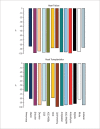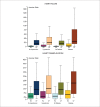Reverse auction: a potential strategy for reduction of pharmacological therapy cost
- PMID: 26200898
- PMCID: PMC4592175
- DOI: 10.5935/abc.20150076
Reverse auction: a potential strategy for reduction of pharmacological therapy cost
Abstract
Background: Polypharmacy is a significant economic burden.
Objective: We tested whether using reverse auction (RA) as compared with commercial pharmacy (CP) to purchase medicine results in lower pharmaceutical costs for heart failure (HF) and heart transplantation (HT) outpatients.
Methods: We compared the costs via RA versus CP in 808 HF and 147 HT patients followed from 2009 through 2011, and evaluated the influence of clinical and demographic variables on cost.
Results: The monthly cost per patient for HF drugs acquired via RA was $10.15 (IQ 3.51-40.22) versus $161.76 (IQ 86.05‑340.15) via CP; for HT, those costs were $393.08 (IQ 124.74-774.76) and $1,207.70 (IQ 604.48-2,499.97), respectively.
Conclusion: RA may reduce the cost of prescription drugs for HF and HT, potentially making HF treatment more accessible. Clinical characteristics can influence the cost and benefits of RA. RA may be a new health policy strategy to reduce costs of prescribed medications for HF and HT patients, reducing the economic burden of treatment.
Conflict of interest statement
No potential conflict of interest relevant to this article was reported.
Figures


Similar articles
-
Resource utilization and cost of heart failure associated with reduced ejection fraction in Swedish patients.J Med Econ. 2012;15(5):938-46. doi: 10.3111/13696998.2012.686464. Epub 2012 May 17. J Med Econ. 2012. PMID: 22510016
-
Retrospective claims database analysis to determine relationship between renin-angiotensin system agents, rehospitalization, and health care costs in patients with heart failure or myocardial infarction.Clin Ther. 2008;30 Pt 2:2217-27. doi: 10.1016/j.clinthera.2008.12.005. Clin Ther. 2008. PMID: 19281916
-
Outpatient costs of medications for patients with chronic heart failure.Am J Crit Care. 2002 Sep;11(5):474-8. Am J Crit Care. 2002. PMID: 12233973
-
Economic burden of heart failure: investigating outpatient and inpatient costs in Abeokuta, Southwest Nigeria.PLoS One. 2014 Nov 21;9(11):e113032. doi: 10.1371/journal.pone.0113032. eCollection 2014. PLoS One. 2014. PMID: 25415310 Free PMC article.
-
[Pharmacoeconomics in cardiovascular disease. Part 2: pharmacoeconomics in congestive heart failure and arterial hypertension].Pol Arch Med Wewn. 2003 Nov;110(5):1375-8. Pol Arch Med Wewn. 2003. PMID: 16737010 Review. Polish. No abstract available.
References
-
- Bocchi EA, Arias A, Verdejo H, Diez M, Gómez E, Castro P, Interamerican Society of Cardiology The reality of heart failure in Latin America. J Am Coll Cardiol. 2013;62(11):949–958. - PubMed
-
- Bocchi EA, Marcondes-Braga FG, Ayub-Ferreira SM, Rohde LE, Oliveira WA, Almeida DR, et al. Sociedade Brasileira de Cardiologia III Diretriz Brasileira de Insuficiência Cardíaca crônica. Arq Bras Cardiol. 2009;93(1) supl 1:1–71. - PubMed
-
- Chase SL, Pickworth KK. Clinical and economic implications of new strategies for heart failure managed care setting. Pt 2Pharmacotherapy. 2007;27(4):29S–32S. - PubMed
-
- World Health Organization (WHO) Global comparative pharmaceutical expenditures with related reference information: health economics and drugs series. No. 003. [2014 Jan 4]. Available from: http://apps.who.int/medicinedocs/documents/s18569en/s18569.
Publication types
MeSH terms
LinkOut - more resources
Full Text Sources
Other Literature Sources
Medical
Research Materials
Miscellaneous

